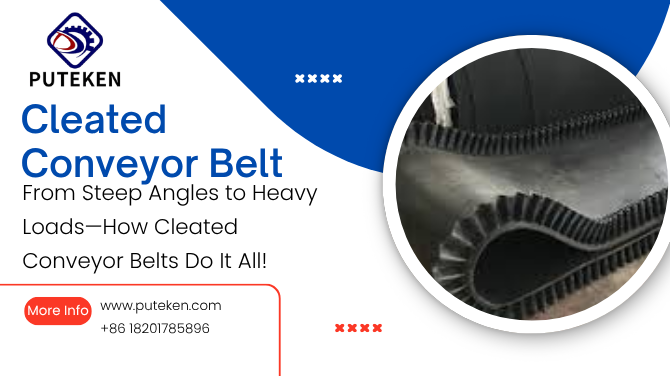Notifications

8 minutes, 28 seconds
-17 Views 0 Comments 0 Likes 0 Reviews

When it comes to moving materials efficiently and safely across production lines or up steep inclines, not all conveyor belts are built the same. Enter the Cleated Conveyor Belt—a powerhouse in material handling that's gaining traction in nearly every industry. Whether you’re in mining, agriculture, food processing, or recycling, cleated belts are proving indispensable.
Structure and Material Composition
A cleated conveyor belt is essentially a traditional belt with added ridges, known as cleats, running across its surface. These cleats are made from materials like rubber, PVC, or thermoplastics, depending on the application. The base belt is usually reinforced with layers of fabric, steel, or Kevlar to handle stress and strain.
The cleats come in various shapes and sizes:
Functionality That Elevates
Here’s where cleated belts truly shine—they prevent slippage on steep angles and maintain even spacing between products. That means no rolling back, no jamming, and a smoother, safer operation overall.
Recycling & Waste Management
Irregularly shaped and unpredictable materials make recycling a unique challenge. These belts offer the traction and control needed to keep things flowing without disruptions.
Key Benefits of Cleated Conveyor Belts
Customization & Flexibility
Cleated belts aren’t one-size-fits-all. You can customize:
This means no matter your need, there’s a belt tailored for it.
Durability in Harsh Conditions
Thanks to their high-quality construction, these belts are resistant to:
Choosing the Right Cleated Conveyor Belt
Factors to Consider
Before you pick a belt, ask yourself:
What materials are being conveyed?
How steep is the angle?
Are there environmental hazards like oils, water, or heat?
Matching Belt with Application
Working with an experienced provider like Shanghai Puteken ensures you don’t get a cookie-cutter solution. Their team evaluates your specific needs and customizes a belt system to match.
A recycling plant in Germany saw a 30% increase in throughput after switching to Puteken’s cleated belts. Meanwhile, an agricultural co-op in Australia eliminated 90% of product slippage in their grain handling system.
Maintenance and Longevity Tips
Routine Inspections
Don’t wait for problems to show up. Regularly check for:
Cleaning for Performance
A buildup of dust, oil, or debris can cause unnecessary wear. Clean belts routinely with non-abrasive agents suited to the material type.
Scheduled Replacements
Even the best belts don’t last forever. Replace when:
Sustainability and Cleated Belts
The Future of Cleated Conveyor Belts
Automation Integration
Future cleated belts are already being designed with built-in sensors that track:
Advanced Materials
Think self-healing polymers and nanotech-infused surfaces. These materials will make belts even more resistant to wear, while increasing lifespan dramatically.
Why You Should Partner with Shanghai Puteken?
Quality Engineering
Shanghai Puteken’s engineering team focuses on:
Industry-Focused Solutions
Rather than general-purpose products, their belts are designed with specific industries in mind—agriculture, food processing, mining, and more.
Global Customer Trust
With clients in over 40 countries, Shanghai Puteken has become a go-to partner for businesses aiming to optimize their material handling operations.
Cleated conveyor belts aren’t just another piece of equipment—they're critical to keeping production lines moving smoothly and safely. From steep inclines to abrasive environments, they handle the toughest jobs without breaking a sweat.
When you combine cutting-edge materials with smart engineering and industry experience, as Shanghai Puteken Transmission System Co., Ltd. does, you get a belt that does more than transport—you get a belt that transforms.
Cleats come in various shapes like T, L, V, and U to match different applications and angles.
Absolutely. Their design keeps items secure, even in slippery conditions.
Depending on the cleat design, some belts can handle inclines over 45 degrees.
Yes. Food-safe materials like FDA-approved rubber and thermoplastics are available.
They offer custom solutions with high durability, tailored cleat designs, and expert support across industries.

